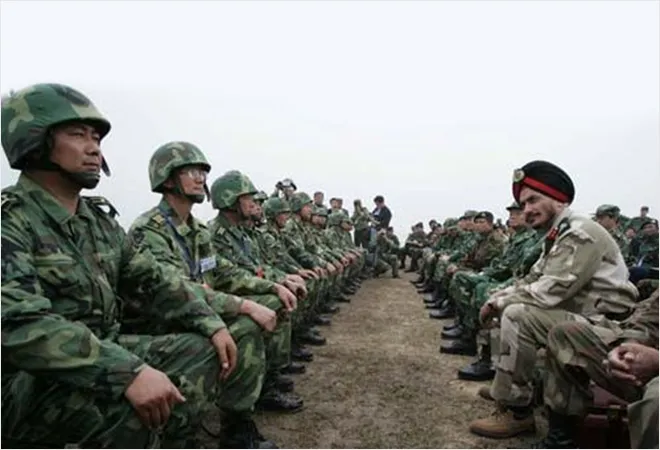How are we to look at the latest disengagement process between India and China in eastern Ladakh? As of now, the process has been applied in two places — Galwan in July 2020, after the horrific June 15 clash that took the lives of 20 Indian soldiers and four PLA personnel, and now on both banks of Pangong Tso. The issue in Gogra and Hot Springs was not so much encroachment as the buildup of forces opposite the Indian positions which will come under the rubric of ‘de-escalation’. As for the Depsang blockade, it’s not clear whether it is on the agenda at all.
The ‘Y’ junction in the Depsang area prevents Indian patrols to a large chunk of the LAC. The government has provided no information as to what’s happening there.
Officially, the first detailed picture of what had happened in Ladakh was provided by Defence Minister Rajnath Singh to the Lok Sabha on September 15. He had said in April that India had noted ‘a buildup of troops and armaments’ on the Chinese side of the border in eastern Ladakh. In early May, the Chinese had begun to hinder the normal patrolling in the Galwan Valley area, leading to a faceoff. Even as this was being addressed, the Chinese ‘made an attempt to transgress’ in Kongka La, Gogra and the north bank of Pangong Tso.
On August 29-30, Indian forces pre-empted a Chinese move and occupied the heights on the Kailash Range along the LAC in the south bank of Pangong Tso. This was a significant development as it gave them a view of significant Chinese deployments in the Spanggur Tso area. This played a significant role in persuading China to back off.
But the minister’s statement ignored the blockade at the ‘Y’ junction in the Depsang area which prevents Indian patrols to a large chunk of its claimed LAC. The government has provided no information as to what is happening there.
After the Galwan clash, renewed efforts towards disengagement were undertaken in early July by NSA Ajit Doval and Chinese foreign minister Wang Yi which led to a pullback and the creation of a buffer zone in the Galwan area.
This was followed up by a detailed agreement between the Indian and Chinese foreign ministers at a meeting in Moscow on September 10. This led to nine rounds of meetings between the senior commanders of the two sides, as well as diplomatic talks, leading to an agreement for disengagement in the Pangong Tso area last month. The 10th round took place on February 19.
On February 11, Rajnath Singh had announced the disengagement in the Rajya Sabha. He said as per the agreement, the Chinese would keep their presence east of Finger 8 and India would do so near Finger 3. In the area in between there would be a ‘temporary moratorium on military activities’ or a buffer zone. He said a similar process would take place in the south bank, but did not detail the area of withdrawal.
This has since been accomplished.
The minister said ‘outstanding issues’ would be taken up in further discussions. But there seems to be no agreement on pullbacks in Gogra and Hot Springs. There was no word on the Depsang issue. Indian forces are unable to patrol some 800 sq km of territory within its claimed LAC because of a PLA blockade. In an interview, the Army Commander of the Northern Command, Lt Gen YK Joshi, said, ‘Coming particularly to Depsang, this predates the present situation. This is a legacy issue.’
There has been some criticism of the Indian pullback in the south bank heights near Pangong Tso. This was one area where the Indians had established dominating positions that had rattled the Chinese. By giving up these as part of the Pangong deal, India has surrendered the one strong card it had held. However, as retired Lt Gen DS Hooda has noted, ‘When you are bargaining, you give and take.’
The issue that still baffles is what exactly the Chinese were seeking and what they achieved, or didn’t. There has been a lot of talk about how they were filling out their November 1959 line. The problem is that no one knows where this line is, since the letter from Zhou Enlai to Nehru referring to it was not accompanied by a map. We do know their approximate 1960 claim line as it was provided to India, along with a map. In the eastern sector, the Chinese reached their claim — the foothills of the Himalayas — and went back after the ceasefire. In the west, they went beyond their 1960 claim and allegedly pulled back 20 km after ceasefire. The problem is only they know till where they had come. Indian posts had been wiped out and many vacated. The one place we stood our ground was Chushul.
In 2020, their attempted coercion did not work. Now, if the security of Tibet has been a major factor in the Chinese policy towards India, they have just succeeded in undermining it. Their eastern Ladakh misadventure has at last persuaded the Indian Army that the threat is from the north, not the west. The process of rejigging its forces to meet the Chinese challenge has begun. Where just one mountain division existed, there will be two more in Ladakh. In addition, our Army is working out its offensive strategy by reshaping the Mathura-based 1 Corps into a mountain-oriented formation, along with a sister 17 Corps to deal with the eastern contingencies.
This commentary originally appeared in The Tribune
The views expressed above belong to the author(s). ORF research and analyses now available on Telegram! Click here to access our curated content — blogs, longforms and interviews.




 PREV
PREV


